Image Credit: Flickr – Thilo Hilberer
Welcome to the mysterious sport that is World Rally Championship (WRC), if you are not already a rally fan it can be a confusing and scary thing to try and get involved in. Despite being quite popular, taking place all over the world and airing on television in many countries there seems to be a noticeable lack of guides to WRC. Well fear not, intrepid motor sport fan, I’ve got your back.
Now this isn’t the only place you can get some information on the WRC, there is in fact a 98 page rule book where everything you need to know can be found, I’ll even link to it underneath. I will warn you though, by the time you get your head round all the jargon, weird sentence structure and finally reach page 98 you will in fact be a thousand years old. Hey, you might like being a thousand years old, who am I to judge?
Anyway, enough small talk, let’s get down to business.
How The Rally Works
As the name suggests the WRC is raced all over the world, in a really varied mixture of countries, which makes for a great many different terrain types and therefore driving styles. It is part of what makes the WRC as good as it is. The order of the stages and location changes every year but here is a list of the locations being raced in the 2015 season.
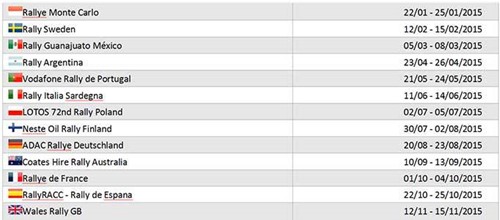
This should give you an idea of how varied each rally can be, for example the differences in terrain between Monte Carlo, Finland and Wales are vast. That makes for a whole different kind of rally. By the way there is no difference between a Rallye and a Rally in this context; it’s just spelling between countries.
Each rally is comprised of a number of timed sections, or stages, of which there are usually between 15 and 25. All of the stages are run on closed roads, dirt, gravel, tarmac, snow, just about every road surface you can think, there is a stage on it.
There is no direct driver to driver racing in the WRC, each driver races the stage one at a time to try and complete it as fast as they can and the timing comes down to 1/10th of a second in some cases. The driver with the lowest combined stage times wins the rally, some drivers are better on certain surfaces so time they lose on one stage can be made up on another later. Points for the top ten finishers are allocated as follows: 25-18-15-12-10-8-6-4-2-1.
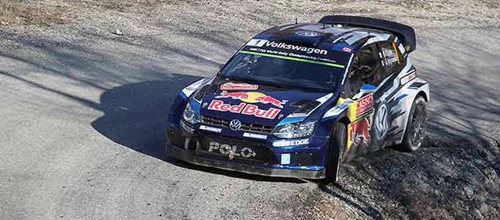
Every driver has a co-driver with them in the car who reads very detailed pace notes (which I will explain later) that give the driver information on what is coming up ahead of them on the road and helps them tackle sections that they can’t even see a lot of the time. There is a great deal of trust involved because at the speeds they are travelling, a small mistake could be fatal!
Typically each rally has the same basic structure. Two days of ‘reconnaissance’, this is where the driver and co driver follow the route at lower speeds in order to practice it and for the co-driver to make pace notes. Without this two day period it would be near impossible to get in a competitive time as they would have no idea what is going to be around the next corner. After the two initial days, the teams run a ‘shakedown’ test, which is a full speed run to make sure the car is competition worthy. This is important not only for the teams, as they can get an idea what they need to do to get the car up to speed and work out any safety concerns, but also for spectators. No one wants to be hit by a car that has come off the track due to something not working properly that might have been caught in shakedown.
The actual competition stages of the rally run for 3 days usually, starting on the Friday and ending Sunday however in some cases they can run for four days, like the Monte Carlo rally for example. The teams however arrive on location days beforehand for set up and the aforementioned reconnaissance and shakedown periods.
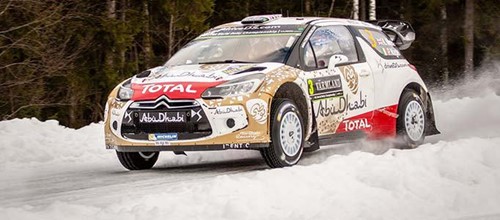
Image Credit: Flickr – Thilo Hilberer
As the rally is run over a number of days, the competitors are able to go to a ‘service park’ at certain points along the rally, which allows team mechanics to perform repairs and fix issues with the vehicle. They are only allowed very limited service times of 10, 30 or 45 minute slots which are pre-determined by race officials. The driver and co-driver are actually allowed to work on their vehicle during the stages, away from the service park, but only using tools they have carried with them in the car. After each day of racing the cars are inspected and put in Parc Ferme, a secure area where teams are not allowed to work on their vehicle. It ensures a fair playing field come morning.
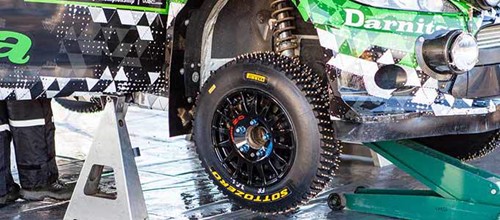
The teams can be given time penalties by race officials if their visits to the service park exceed the allotted time allowance. Penalties can also be dished out for arriving late at stages and various other check points in the event.
Pace Notes
Pace notes are the magical language through which a co-driver communicates with his driver. At least that is what it sounds like when they are being read out. In actuality they are, simply put, shortened route instructions, nothing magical here! The shortened nature of the notes comes out of necessity, for the notes to actually be useful to the driver they need to be able to be relayed very quickly and concisely. There is no set way to produce pace notes, a driver and co-driver can produce them however they want, in the way that works the best for the pair, but they are generally all quite similar. They can vary in the type of measurement used, metric or imperial and can be in the preferred language of the team.
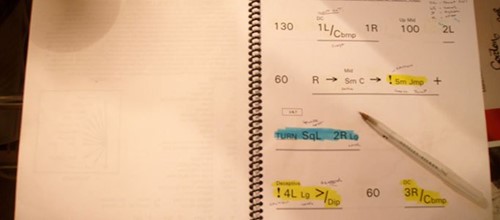
Image Credit: Wikipedia – Prolog
They provide a wealth of information using a very small number of words. Pace notes describe the general route to be taken as well as turnings, speed to approach corners, junctions, severity of bends, crests, jumps, surface type, potholes or irregularities in the road, pretty much everything that might affect the vehicle needs describing in some way.
In the WRC the co-driver and driver scout and create their own notes, however in some rallies it is the organiser that provides the notes so that everyone is on the same level.
None of that is going to help you understand what the co-driver is talking about when he starts reading out the pace notes though, which is why I have provided an example and translation below.
Pace Notes
1. Start, 30, Keep left over a crest into short 4 right plus opens, 60, crest and 6 right plus and don’t cut short 6 left minus.
2. 60, line into 2 right minus over a bump tightens to a hairpin over a ditch.
3. Into 6 left long opens over a crest, 30, 6 right into 3 left plus long don’t cut tightens to 1, into a short 1 right plus and short 2 left minus tightens at junction (junction 2 at 0.6kms) 20.
Translation
1. Start, drive 30 metres then keep left over a crest into a fast fourth gear right-hand corner, accelerate for 60 metres to a crest, then stay in the middle of the road for a sixth gear left hand corner in half throttle.
2. Drive 60 metres, keep to the left hand side of the road for a second-gear right-hand corner, which tightens very badly over a bump, at the same time brake hard for a hairpin over a drainage ditch.
3. Accelerate flat out into a sixth-gear long, left-hand corner over a crest, drive 30 metres then into a sixth gear right-hand corner, brake hard for a third gear left-hand corner in half throttle. Stay in the middle of the road for their are some bad rocks on the inside, and then brake as it tightens to first-gear, immediately changing direction into a fast, first-gear right-hand corner. Then accelerate into a second-gear left-corner past a junction (junction No 2 in the road book at 0.6 Kms), carry on for 20 metres.
To see how much of the difference those notes make, have a go at reading both versions out and see how much faster the pace notes are! It is quite noticeable.
WRC Cars
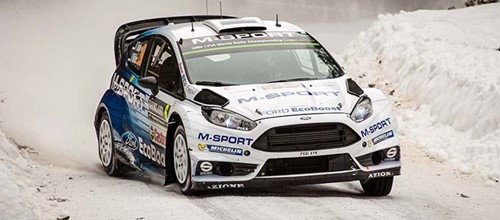
Image Credit: Flickr – Thilo Hilberer
The cars are capable of quite extraordinary things, they have to deal with huge ruts in roads, giant pot holes, jumps that would crush a normal cars suspension and be able to deal with severe snow and ice. It isn’t just road conditions they have to conquer though, it’s also temperature. The car needs to be able to handle scorching temperatures one round and -30°C the next.
As mentioned before the cars are similar to the cars you see on the street in looks only. After they receive the standard car they completely strip it down to its shell and then rebuild it themselves to rally spec from this point up. Everything that isn’t absolutely necessary is taken off to save weight and then the chassis and shell of the car are strengthened and made much stiffer than the factory versions. Every car that takes part in the WRC, even its supporting classes, is required to have a super strong steel roll cage to protect the occupants in the case of a crash.
The WRC is a really superb competition and if you are looking for a change from Formula One, I highly recommend checking it out if you don’t already follow it. It is quite the spectacle and there is rarely a dull moment. Some of the moves WRC drivers pull are beyond belief. Don’t take my word for it though, check out 2014 highlights below and see for yourself!
I hope this guide has been useful for you, there are certainly aspects that aren’t in here but this is a beginners guide after all. If you have any suggestions I would love for you to let me know in the comments section and I’ll get them added!
Why not check out our other beginners guides and get yourself up to speed!

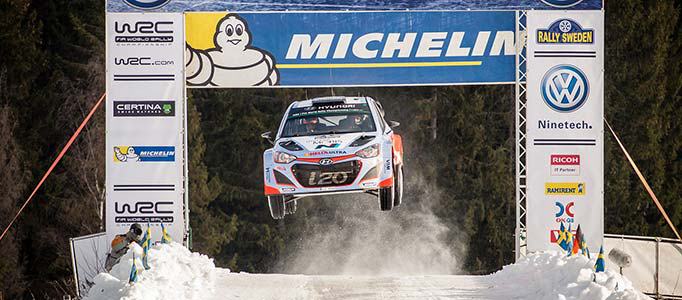



 Facebook
Facebook Twitter
Twitter Instagram
Instagram LinkedIn
LinkedIn Youtube
Youtube